Although the European Economic and Social Committee exists since 1957, there is only scarce literature on this institution. While in the 80s and 90s a few articles and books were published, there has been hardly any literature since 2000. This mere fact may already provide an indication of the Committee’s role in today’s institutional structure of the European Union: Civil society has found other ways of representation. On the one hand, formal ways of participating in the decision making process increased, for instance through the various consultative bodies around the European Commission. On the other hand, informal participation through lobbying has grown and is often regarded as being more profitable and more efficient than the involvement of an assembly with 344 members which has to agree with a majority on its opinions.
Not only on this account is the work of the EESC facing critics. Under the heading “Four good reasons to abolish the Economic and Social Committee”, Helle Thorning-Schmidt (2003), member of the European Convention and European Parliament, challenges the Committee’s right to exist. Her accusations are profound: Unfocused, too expensive, inefficient and not sufficiently European was the EESC’s work.
Other authors are not so pessimistic. Vierlich-Jürcke (1998) refers to the Committee’s ability to “democratize” the decision making system in the European Union by fostering the dialogue between government and the public. Smismans (2000) agrees on these positive effects, but is in favour of some changes to the composition of the Committee. He wants to strengthen links between civil society, broaden the deliberative basis and bring more expertise. He states that an increased input-legitimacy contributes to output-legitimacy.
On a more abstract basis, the critics are not only about efficiency and legitimacy. The question whether the Committee has (still) a right to exist touches the concept of democracy we want to establish in the European Union. The EU has been a “participatory democracy” from the beginning, and the Constitution’s article 46 again strengthens possibilities to participate.
Inhaltsverzeichnis (Table of Contents)
- Introduction
- The input-side: The EESC and (participatory) democracy
- The EESC and democracy
Zielsetzung und Themenschwerpunkte (Objectives and Key Themes)
This essay analyzes the European Economic and Social Committee (EESC) and its role in the European Union's (EU) concept of participatory democracy. It examines whether the EESC is a sufficient institution for participation by evaluating its contributions to both input and output legitimacy.
- The development of participatory democracy in the EU
- The EESC's role in promoting dialogue and representation
- The EESC's contribution to democratic legitimacy in the EU
- The limitations of the EESC in terms of decision-making power and representation
Zusammenfassung der Kapitel (Chapter Summaries)
The introduction sets the context by highlighting the lack of literature on the EESC and the challenges it faces in contemporary EU governance. It introduces key criticisms of the EESC, focusing on its efficiency, legitimacy, and relevance in a changing EU landscape. The author then lays out the core question of the essay: whether the EESC is a sufficient body for participation in the EU's evolving model of democracy.
The second chapter explores the input-side of the EESC's role in participatory democracy. It traces the development of participatory democracy in the EU, highlighting the increasing importance of citizen engagement and the role of the EESC in facilitating dialogue between civil society and EU institutions. It discusses the EESC's efforts to strengthen its links with NGOs and its contributions to representing the views of specific groups of citizens.
Schlüsselwörter (Keywords)
European Economic and Social Committee (EESC), participatory democracy, democratic deficit, EU institutions, civil society, NGOs, input legitimacy, output legitimacy, decision-making, representation.
- Quote paper
- Daniel Neugebauer (Author), 2007, The European Economic and Social Committee - A sufficient institution for participation?, Munich, GRIN Verlag, https://www.hausarbeiten.de/document/70305


